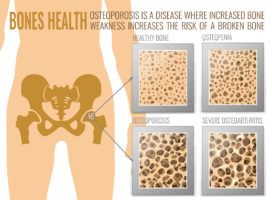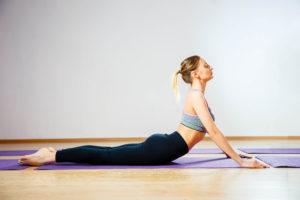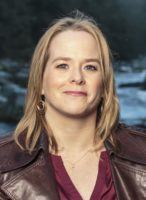Pilates For Osteoporosis
It was that simple. My mother lifted a heavy tea pot at a church social event. She lifted a tea pot, turned to serve a cup, and felt a sudden and excruciating pain in her back. In that instant, she had fractured a vertebra in her spine. Shortly thereafter, Mum was diagnosed with osteoporosis. The unfortunate tea pour was the first of several spinal fractures over the years, usually involving fairly mundane movement. A hip fracture followed later, after a fall in an icy parking lot.
More fractures, longer recoveries and constant pain meant that Mum’s physical activity declined dramatically. Due to the collapsed vertebrae in her spine, she could no longer stand fully upright. Her strength and mobility slipped away as her pain increased. In the decade before her death at age 85, my Mum was hospitalized several times. A hip replacement, necrosis in the bones, and another hip replacement. Osteoporosis was ultimately a contributing factor to her death. (In hospital, she contracted and finally succumbed to an antibiotic resistant infection.) My mother’s two sisters and her brother also developed the disease. In my more dramatic moments, I imagine osteoporosis looming over my head like a scythe ready to strike; potentially threatening my activity and independence as I age. I am determined that this is not my future!
The Statistics Are Sobering
An estimated 1 in 3 women will experience a fracture due to osteoporosis in their lifetime. For men, that number is closer to 1 in 5. Osteoporosis fractures are more common than heart attack, stroke and breast cancer combined. A full 80% of fractures in post-menopausal women are attributable to osteoporosis. It often goes undetected, even after a fracture has occurred. Have I got your attention yet? This is a condition to take seriously!
As with any medical condition, the best early defense is education. Osteoporosis Canada has a “Know your Risk” Quiz you can take online to determine how susceptible you may be to this stealthy disease. Nutrition, physical activity and general health guidelines go a long way toward minimizing your risk. Understand your risk, and take whatever steps you can to maintain those healthy bones!
What is osteoporosis?
 Osteoporosis is a condition in which the bones begin to degenerate and become more porous and brittle. The disease can develop undetected for years with symptoms. As it progresses, the internal structure of the bones becomes fragile, and less able to support load. The most common fracture sites are in the spine, the hip, the wrist and the shoulder. Although deficits in nutrition, physical activity and hormones seem to be linked to osteoporosis, researchers have so far found no single cause for this disease.
Osteoporosis is a condition in which the bones begin to degenerate and become more porous and brittle. The disease can develop undetected for years with symptoms. As it progresses, the internal structure of the bones becomes fragile, and less able to support load. The most common fracture sites are in the spine, the hip, the wrist and the shoulder. Although deficits in nutrition, physical activity and hormones seem to be linked to osteoporosis, researchers have so far found no single cause for this disease.
Load the Bones! Prevention Through Movement
In addition to nutrition and good hormone support, weight bearing exercise is the best way to build and maintain healthy bones. The healthier the bones are through our lifetimes, the more likely they are to withstand the effects of age-related bone loss. Move, move and move some more!
But we can do more. In an osteoporosis-free body, Pilates exercise is a great tool for supporting and improving overall bone health. Pilates improves bone density by using resistance to move body parts against gravity and resistance. After a diagnosis, Pilates for osteoporosis can be a safe and supportive exercise. It is important to realize thought that not ALL Pilates is suitable for people with osteoporosis and its precursor, osteopenia. There is a lot to learn about exercising safely with this condition. Let’s take a closer look at a few of the most important points.
Some Movements Are NOT Recommended
One of the most common osteoporosis fractures is a wedge fracture of a vertebra. Under the right stress, the front (ventral) edge of the vertebral body collapses forward. (This was my Mum’s “tea pouring” fracture). The vertebra is transformed into a wedge shape. An accumulation of these in the spine results in a loss of height, and contributes to what we know as the “dowager’s hump.” The body loses the support of the front side of the spine, and may become unable to straighten up.
Studies show that a few specific kinds of movement present increased risk of fracture in people with osteoporosis.
Forward bending, twisting and rolling are a few of the most important movements to avoid in an exercise setting – especially if you’re loading them. Any exercise with a likelihood of falling is probably best to avoid as well.
Pilates for Osteoporosis
If you’ve ever done any Pilates, you know that many of the fundamental movements involve curving the spine forward, twisting and rolling. You need to know that a standard Pilates program is NOT safe for osteoporosis. However, with a program specialized to support the needs of an osteoporosis client, Pilates can be one of the best forms of exercise for this condition. Here’s why:
- Focus on Alignment
The Pilates method works to support the whole spine. Focused movements create more optimal alignment between the spine, pelvis, hips, legs, feet, shoulders and head. Exercising in a way that promotes balanced support of the joints in the body promotes ease and minimizes non-optimal loading patterns. Learning to support great posture and decompress the spine is essential! - Core Stability
Training deep stabilizing muscles in the body and integrating them into movement is key in creating optimal support for living life outside the Pilates studio or exercise gym. Remember, the core is not just about abdominal muscles. Understanding and improving the relationship between the deep abdominal and back muscles, pelvic floor and respiratory diaphragm, through different ranges of motion, at different speeds and under different loads improves your ability to move well through ALL the different movements your life demands.  Spinal Extension
Spinal Extension
Our lives tend to be very forward focussed. Between computers, watching tv, cooking, reading, sitting etc; our bodies can “forget” how to move well out of those slouchy, forward positions. Pilates exercises that promote chest expansion, spinal and thoracic extension help to counteract the forces of forward flexion. The ability to extend, and to live life in a more upright position helps to minimize compressive stress on the vertebrae.- Balance
A key to avoiding osteoporotic fractures is fall prevention. Balance challenges are important, as are movements that challenge the vestibular system; the part of the brain that helps us be aware of our positioning in space, and integrates visual information. Moving the body safely through small proprioceptive tasks and larger gross motor movements helps us to create the capacity to move the body well even in unstable settings. They key is starting comfortably; gradually dialling up the challenges as the body and brain can manage safely. - Working Around Limitations
Life doesn’t stop with the onset of osteoporosis. We’ve got to keep moving! People with an osteoporosis diagnosis still have to do some degree of spinal rotation! Rotation happens when we open doors, turn our heads, lean forward to hug little ones or take out the garbage. Continued movement helps us maintain the fun, physical activities that bring us joy, helps us stay connected to the people we care about and allows us to continue living independently.
We have to find ways to support the body in as full a range of motion as possible. Pilates can provide loaded and/or supported challenges in your body without necessarily twisting or curling your spine. A well-trained Pilates professional can show you ways to do the meaningful physical tasks in your life in a safer way.
Move your Bones
Osteoporosis is a real thing that can have a profound affect on quality of life and independence as we age. The more we can move our bodies and load the bones in a variety of different ways, the more likely we will be to have strong bones as we age. And if you have a diagnosis of osteopoenia or osteoporosis, HOW you move matters even more than before. Learn to decompress your structure and move in a way that supports your bones and your joints.
If you have questions or comments , please leave them in the comments below, or connect with us at the studio. Movement is our jam, and we’re happy to help!! If you’d like to explore Pilates and Movement Programs with us, check out our Getting Started Guide, or book an Introductory Private Training Package today!
About Susannah Steers
 Susannah is a Pilates and Integrated Movement Specialist, and owner of Moving Spirit. Through movement teaching, speaking, and facilitating workshops, she supports people in creating movement practices that promote fitness from the inside out. She loves building community, and forging multi-disciplinary connections. Susannah co-hosts The Small Conversations for a Better World podcast – an interview based podcast dedicated to promoting the kind of conversations about health that can spark positive change in individuals, families, communities and across the globe.
Susannah is a Pilates and Integrated Movement Specialist, and owner of Moving Spirit. Through movement teaching, speaking, and facilitating workshops, she supports people in creating movement practices that promote fitness from the inside out. She loves building community, and forging multi-disciplinary connections. Susannah co-hosts The Small Conversations for a Better World podcast – an interview based podcast dedicated to promoting the kind of conversations about health that can spark positive change in individuals, families, communities and across the globe.
